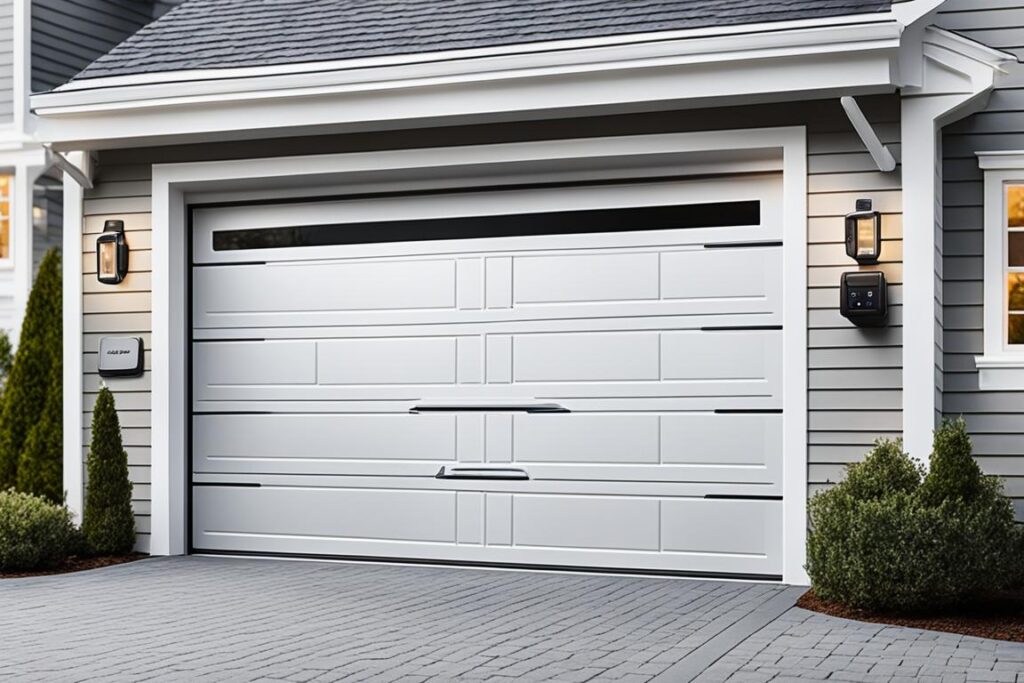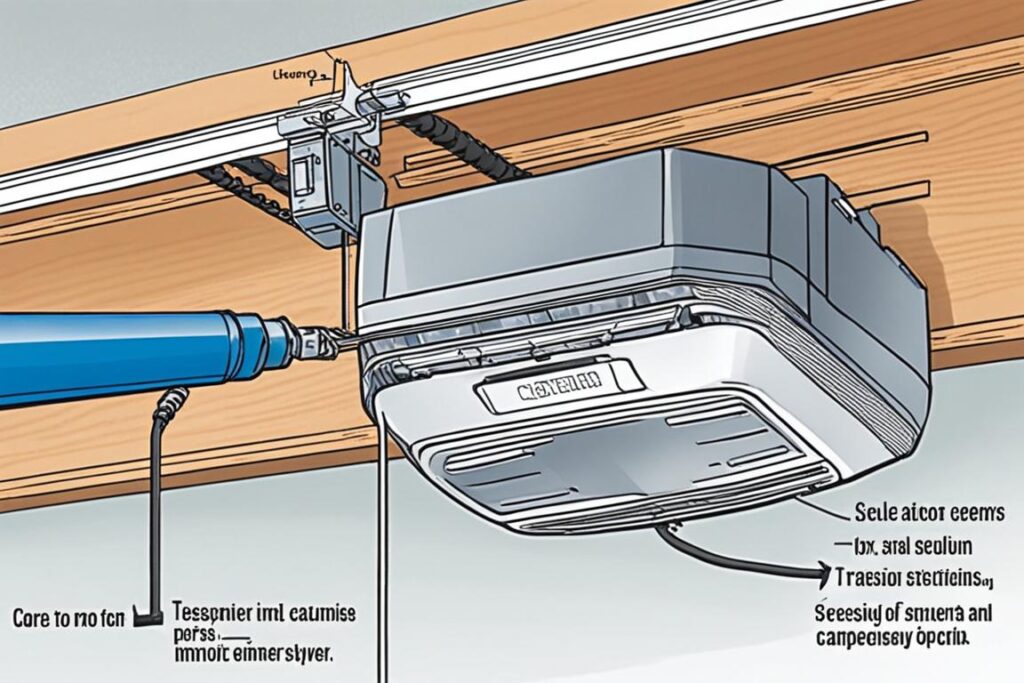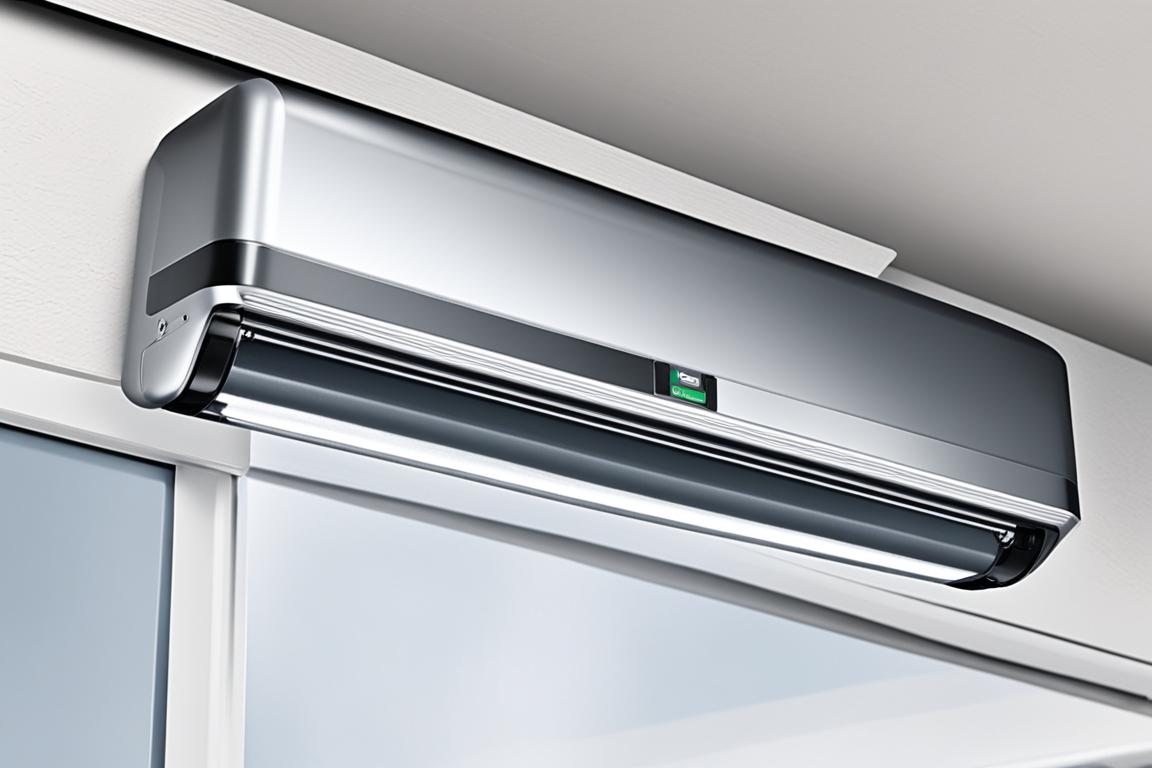Welcome to the comprehensive manual guide on DC motor openers for your garage door system. In the sphere of home improvement, the right garage door automation can be a game-changer, not only in terms of convenience but also when considering garage door safety. Whether you’re adept at handling tools or new to the realm of garage door installation, understanding the ins and outs of your DC-powered opener is essential for any homeowner looking to enhance their property.
From the initial setup to routine maintenance, this guide will take you through the pivotal steps necessary to achieve a seamlessly operating garage door. With our detailed walkthrough, even the most intricate aspects of these advanced systems will be demystified, ensuring that your experience with garage door automation is both effective and gratifying.
Key Takeaways
- Essential information on setting up and utilizing a DC-powered garage door opener
- Insights into the significant features and benefits of DC motor technology
- Understanding the importance of safety and convenience in modern home improvement
- Tips on maintenance to ensure long-term performance and durability
- Guidance for homeowners to make informed decisions regarding garage door automation
Understanding DC Powered Garage Door Openers
As we delve into the world of garage door automation, the distinctive benefits of DC-powered garage door openers stand out. We aim to unveil the superiority of DC motor technology in residential applications, emphasizing pivotal advantages such as energy efficiency, quieter operation, and speed control. These attributes not only improve the user experience but also contribute to the mechanical longevity of your garage system, a vital consideration for any homeowner.
Benefits of DC Motors in Garage Door Openers
DC motors have revolutionized garage door openers by offering a quieter and more energy-efficient solution. Unlike their AC counterparts, DC motors adjust speed effortlessly, thus providing superior speed control. This enhanced feature allows for smoother operation, reducing stress on the motor and extending the life of your garage door opener. Moreover, the significant reduction in noise level makes DC motors the go-to choice for a peaceful home environment.
How DC Garage Door Openers Work
The mechanics behind DC garage door openers reflect ingenuity and efficiency. These systems convert electrical energy into mechanical energy with minimal energy loss, resulting in an eco-friendly performance. Advanced speed control, facilitated by electronic controllers, enables DC motors to operate at variable speeds, offering a quieter operation and softer start and stop that aid in preserving the integrity of the garage door’s moving parts.
Comparing AC vs. DC Powered Garage Door Openers
When considering an upgrade or installation of a garage door opener, the choice between AC and DC motors is crucial. AC motors have long been a standard in the industry, known for their simplicity and power. However, DC motors outpace them by exhibiting exceptional energy efficiency and mechanical longevity. This longevity factor is significant as it results in fewer replacements and repairs over time.
- AC Motors: High power, consistent speed, cost-effective, but lacking in speed variability and noise control.
- DC Motors: Enhanced speed control, lower energy consumption, quieter operation, and longer lifespan due to reduced wear and tear.
The transition from AC to DC motors in garage door openers is a direct response to the evolving needs of modern homeowners. Prioritizing the quietness of operation, durability, and adaptable performance, DC powered garage door openers offer an innovative solution that aligns with contemporary lifestyle standards.
Key Features to Look for in DC Powered Garage Door Openers
When upgrading your garage to the latest in convenience and technology, selecting a DC powered garage door opener with intelligent design is essential. Understanding the features that align with home automation compatibility, emergency preparedness, and customizable operation will ensure you choose a system that meets modern demands. Here are key features that should guide your decision-making process:
Soft Start and Stop Functionality
The hallmark of a garage door system that champion’s longevity is its soft start and stop functionality. This feature allows for a more refined movement of the door, dramatically reducing wear and tear on gears and resulting in a quieter operation. A door opener engineered with this intelligent mechanism extends the lifespan of the entire system and enhances the user experience.
Battery Backup Options
A crucial aspect of emergency preparedness is ensuring your garage door opener comes equipped with a reliable battery backup. In the event of power outages, a battery backup will keep your garage door operational, ensuring you’re never left stranded outside. This addition is invaluable, particularly in regions prone to severe weather and frequent power disruptions.
Integration with Smart Home Systems
For those with a penchant for smart technology, home automation compatibility is non-negotiable. Selecting a garage door opener that seamlessly integrates into your existing smart home ecosystem enriches daily life. Look for options that support customizable operation through mobile apps and wireless connectivity, putting control at your fingertips and offering unmatched convenience.

Selecting the Right DC Powered Garage Door Opener for Your Home
When it comes time to choose a DC powered garage door opener, there are critical factors to consider that go beyond just price and aesthetics. Specifically, homeowners must account for garage size, door weight, the durability of the opener, brand reliability, and how user-friendly the system is. A well-chosen opener can greatly enhance your home’s functionality and can save you from unnecessary hassle in the future.
Firstly, garage size dictates the power level required from your opener. Standard single doors typically need less power compared to double doors that cover a two-car garage. It’s essential to select an opener with sufficient force to handle the door weight without overburdening the motor, preserving the opener’s durability.
Door weight is another determining element affecting your choice. Heavier materials like solid wood or insulated doors will need a more robust system designed for that weight class. Compatibility between the opener and door weight is vital to prevent strain on the motor and ensure opener durability.
Reliability extends beyond the opener itself and to the manufacturer. Opting for an opener from a company known for brand reliability can save you from future headaches. Brands with established reputations are more likely to offer warranties, robust customer service, and quality parts, making maintenance or service issues more manageable.
Additionally, in today’s high-tech world, usability is paramount, and opting for a user-friendly design can make daily operation a breeze. Look for features like smart home connectivity, easy-to-program settings, and clear instruction manuals that can make your DC powered garage door opener a delight to use.
Below is a checklist to help guide you through your purchase:
- Measure your garage to ensure you choose an opener with adequate power.
- Weigh your door or check the spec to match with an opener’s capacity.
- Research the longevity and customer satisfaction of different brands.
- Consider features that enhance usability, such as remote controls and app integration.
By mindfully considering these aspects when selecting your garage door opener, you can ensure a fit that is just right for your home. Not only does this promote a hassle-free installation and daily use, but it also aligns with a commitment to long-term, trouble-free operation.
Garage Door Opener DC Powered Manual Installation Tips
Taking the do-it-yourself installation route for your garage door opener can be both a gratifying and cost-effective DIY project. Nonetheless, this task warrants a precise installation guide, a comprehension of garage door safety, and the proper tools to ensure professional setup quality. Embarking on this journey will provide an intimate understanding of the mechanisms that secure and grant access to your home.
Tools and Equipment Needed
Before diving into the installation process, gather the following tools and equipment to ensure a smooth operation:
- Adjustable wrench
- Screwdriver set
- Socket set
- Drill with bit set
- Stepladder
- Level
- Tape measure
- Wire stripper/cutter
- Hammer
- Pencil for marking drill points
Step-by-Step Installation Process
With your workspace cleared and tools at hand, follow this detailed guide to ensure your garage door opener is installed correctly:
- Unpack all components of your garage door opener and lay them out for easy access.
- Using the manual, identify and assemble the main parts of the opener.
- Install the power unit high enough so that tall individuals won’t encounter it, typically 7 feet from the floor.
- Attach the rail to the power unit and position the trolley over the rail.
- Fix the mounting bracket (that connects to the garage door) to the garage’s framing.
- Align the rail with the center of the garage door and secure it to the bracket.
- Attach and connect the door arm to the trolley and door bracket.
- Install the electric eye safety system that comes with the opener, ensuring proper alignment for optimal safety.
- Program the opener following the manufacturer’s instructions, which may include setting up remote controls or keypads.
- Finally, test the garage door opener to ensure it functions correctly.
A successful installation is marked by the door opening smoothly, quietly, and safely.
Safety Precautions and Best Practices
During installation, prioritize your safety and the operational integrity of the garage door opener by adhering to the following practices:
- Turn off power at the circuit breaker to avoid any electrical hazards.
- Use the stepladder carefully, ensuring it is stable and securely placed.
- Follow the manual to the letter; manufacturers provide specific instructions tailored to your model for garage door safety.
- Double-check measurements and alignments to prevent errors that could affect the system’s function.
- Never adjust or remove the garage door’s torsion springs; these are under high tension and pose serious risks.
- Test the auto-reverse feature to confirm the door reverses direction when it encounters an obstruction.
By taking these precautions, you not only protect yourself but also guarantee a safe and efficient operation for years to come.

Embarking on a garage door opener installation may seem daunting, but with the right tools, a comprehensive guide, and a focus on safety, even novice DIY enthusiasts can achieve professional setup results. Remember, taking your time and following the steps meticulously will lead to a successful do-it-yourself installation project, adding both value and convenience to your home.
Conclusion
As we wrap up this comprehensive guide, it’s clear that DC powered garage door openers deliver long-term benefits that resonate with savvy homeowners. The blend of quiet operation, energy efficiency, and advanced technological features positions these openers as ideal for the modern residence. Embracing this form of automation not only elevates the convenience of your home but also plays a part in boosting overall customer satisfaction.
The Advantages of Choosing a DC Powered Garage Door Opener
The decision to opt for a DC powered garage door opener is backed by solid advantages including smoother performance and reduced energy consumption. These openers are engineered to provide unparalleled durability and smart operation, contributing greatly to product reliability. By leveraging these progressive attributes, you can enjoy the peace of mind that comes with a secure and efficient garage door system.
Troubleshooting Common Issues
Despite their advanced design, you might encounter occasional hiccups with your garage door opener. Utilizing a troubleshooting guide can be a quick way to identify and resolve common problems without the need for professional assistance. Whether it’s recalibrating the sensors or resetting the remote control, the solutions are typically straightforward, ensuring your garage door opener’s performance is restored swiftly.
Maintenance Tips to Extend the Lifespan of Your Garage Door Opener
To capitalize on the product reliability of your DC powered garage door opener, establishing a consistent maintenance routine is essential. Regularly inspecting and lubricating moving parts, verifying the alignment of safety sensors, and keeping remote controls in working order will prolong the unit’s lifespan. These simple yet effective measures are the keystones of preventing breakdowns and preserving your home investment for the long run.

